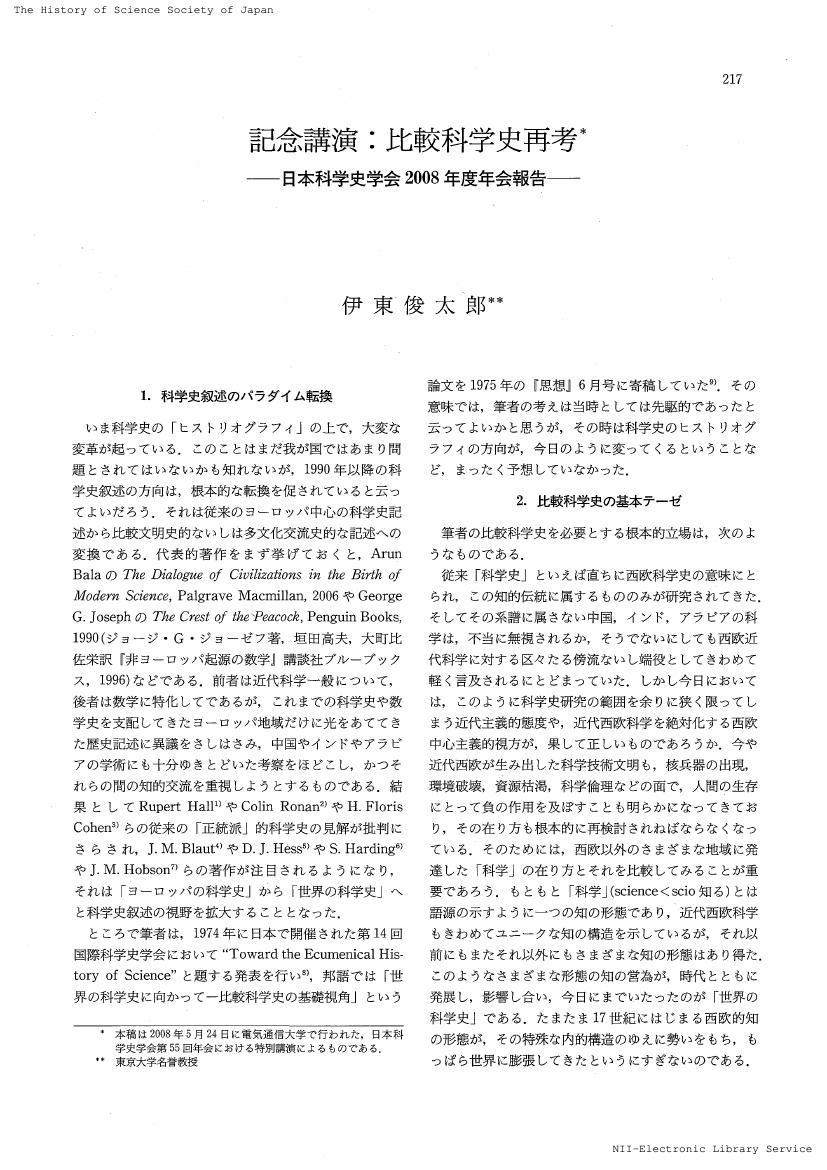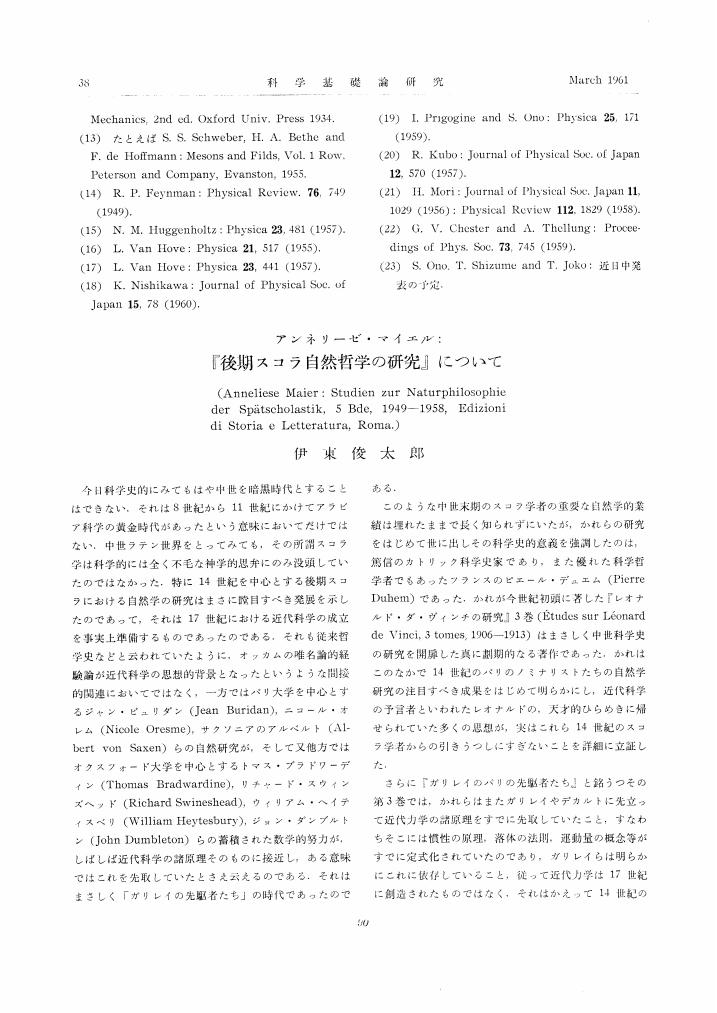11 0 0 0 OA 12世紀におけるユークリッドDataのラテン訳について
- 著者
- 伊東 俊太郎
- 出版者
- 日本西洋古典学会
- 雑誌
- 西洋古典学研究 (ISSN:04479114)
- 巻号頁・発行日
- vol.13, pp.127-141, 1965-03-27 (Released:2017-05-23)
The positive assimilation and recovery by the Latin West of Greek science and civilization took place in the 12th century through extensive translations from Arabic and Greek While the transmission of Greek science through Arabic to the Latin Europe has been considerably clarified by such experts as Suter, Leclerc, Wustenfeld and Steinschneider, many things still remain dark concerning the scientific transmission immediately through Greek, to the Latin West in spite of excellent pioneer studies by Haskins and Heiberg In 1963, I edited the first text of the Latin version of Euclid's Data from the following two extant manuscripts 1 MS Oxford, Bodl Auct F 5 28, 13 c 99 r-113 r 2 MS Paris, Bibl Nat lat 16648, 13-14 c 60 r-91 r By investigating these manuscripts of the Latin Data and others, I have found some interesting new facts about the transmission of scientific works via Greek to the Latin West First of all, the fact that this Latin translation of the Data was made from the Greek is obvious from the following evidences 1 the existence of the direct transliteration of the Greek words, like catigmeni, anigmeni, parathesi, cathetus, orthogonius etc 2 the exact correspondence in particles and conjunctions used in the Greek text and the Latin translation 3 the exactly same order of words is found in both the Greek original and the Latin version The problem of the preparation of this medieval Latin translation from Greek of the Data is divided into three sub-problems 1) Where did this translation take place ? 2) When did the translation come into existence ? 3) Who translated it into Latin ? My conclusions to problems 1) and 2) are as follows 1) This Latin translation was made in Sicily as a part of the vast translation of Greek scientific works which took place there in "the medieval renaissance" 2) This translation came into existence in the middle of the 12th century and not later than 1160 As regards problem 3), which is very crucial to my study, I have reached the following conclusions 3) (i)It is certain that our translator of the Data also made Latin versions from the Greek of Euclid's Optics, Catoptrics and Proclus' Elementatio physica (or De motu) (ii) It is probable that this prolific author is the same person as the anonymous translator of Ptolemy's Almagest who was studied by Haskins and Heiberg These conclusions concerning the identification of the translator have been drawn primarily through a comparative investigation of the texts For the first conclusion, I compared our text of the Latin Data with the Latin version of Euclid's Optics and Catoptrics in the Oxford manuscript (MS Oxford, Bodl Auct F 5 28, 57 r-64 r De visu liber and 64 r-69 r De speculis liber) and with the full text of Proclus' Elementatio physica published recently by H Boese As the result of this investigation, I found that they accord so well in all translating techniques as to ensure the identification of the translator of these four works As far as the second conclusion is concerned, I based it on a remarkable passage in the preface by the Latin translator of Ptolemy's Almagest, which seems to suggest that the translator of the Almagest is the same as that of the other four works above-mentioned This view is also supported by the studies of Haskins and Boese, which confirmed the identity of the translator of the Almagest with that of Proclus' Elementatio physica through their careful comparisons of translating techniques between the two translations These conclusions seem to be very important for the scientific transmission in the early Middle Ages, because, if the same person translated these various works, he would occupy a prominent position in editing the translation of mathematical works from the Greek not unlike that of Gerard of Cremona in the sphere of translation from the Arabic
8 0 0 0 OA 科学史研究を回顧する
- 著者
- 伊東 俊太郎
- 出版者
- 日本科学史学会
- 雑誌
- 科学史研究 (ISSN:21887535)
- 巻号頁・発行日
- vol.50, no.259, pp.144-149, 2011 (Released:2021-07-21)
4 0 0 0 地球環境の変動と文明の盛衰ー新たな文明のパラダイムを求めてー
平成2年9月14日に平成3年度より出発する重点領域研究「地球環境の変動と文明の盛衰」(104 文明と環境)の第1回研究打合わせ会を京都市で実施した。出席者は研究代表者伊東俊太郎ほか13名。全体的な研究計画の打合わせと,今後の基本方針の確認ならびにニュ-スレタ-用の座談を実施した。平成2年12月1日,雑誌ニュ-トン12月号(教育社刊)誌上にて本重点領域研究にかかわる特集を組み,発表した。重点領域研究の広報活動の一環として研究計画の概要を朝日新聞11月6日付,毎日新聞1月3日付,日本経済新聞2月11日付に発表した。平成3年2月21日,ニュ-スレタ-「文明と環境」出発準備号を刊行し,関係者に配布した。内容は対談梅原猛・伊東俊太郎,座談安田喜憲ほか5名,特集,速水融ほかで31ペ-ジの構成である。大変好評で,日本経済新聞3月21日付にも紹介され,多くの研究者,企業関係者から問い合わせが殺到した。平成3年2月28日,第2回研究打合わせ連絡会を京都市で開催した。出席者は伊東俊太郎ほか重点領域計画研究関係者58名であった。午前中全体集会を実施し,午後分科会に分かれて,今後の研究方針について話し合った。今回の研究打合わせにより,58名もの参加者を得たことは,4月以降の本格的な出発に明かるい希望を抱かせた。平成3年3月8日,文部省にて重点領域研究審査会を実施し,公募研究の候補を選定した。
4 0 0 0 OA シンポジウム「学問の分類について」
3 0 0 0 OA 数理哲学の課題について
- 著者
- 伊東 俊太郎
- 出版者
- 科学基礎論学会
- 雑誌
- 科学基礎論研究 (ISSN:00227668)
- 巻号頁・発行日
- vol.3, no.3, pp.471-477, 1957-07-15 (Released:2009-09-04)
- 参考文献数
- 22
2 0 0 0 OA 世界の数記号(科学史入門)
- 著者
- 伊東 俊太郎
- 出版者
- 日本科学史学会
- 雑誌
- 科学史研究 (ISSN:21887535)
- 巻号頁・発行日
- vol.44, no.236, pp.225-231, 2005 (Released:2021-08-11)
2 0 0 0 OA 科学史と科学哲学の融合 アメリカ科学哲学界の一傾向
- 著者
- 伊東 俊太郎
- 出版者
- 日本科学哲学会
- 雑誌
- 科学哲学 (ISSN:02893428)
- 巻号頁・発行日
- vol.5, pp.13-19, 1972-12-25 (Released:2009-05-29)
2 0 0 0 OA 「科学革命」の起源
- 著者
- 伊東 俊太郎 Shuntaro Ito
- 出版者
- 麗澤大学比較文明文化研究センター
- 雑誌
- 比較文明研究 = Journal for the Comparative Study of Civilizations (ISSN:13422650)
- 巻号頁・発行日
- vol.19, pp.109-128, 2014-06-25
- 著者
- 伊東 俊太郎
- 出版者
- 日本科学史学会
- 雑誌
- 科学史研究 (ISSN:21887535)
- 巻号頁・発行日
- vol.47, no.248, pp.217-222, 2008 (Released:2021-08-04)
1 0 0 0 OA アラビア文明圏の科学史と理科教育
- 著者
- 伊東 俊太郎
- 出版者
- 日本科学史学会
- 雑誌
- 科学史研究 (ISSN:21887535)
- 巻号頁・発行日
- vol.43, no.232, pp.235-238, 2004 (Released:2021-08-12)
1 0 0 0 OA シンポジウム:「ユークリッドの種々相」 1993年日本科学史学会年会報告
1 0 0 0 OA 「自然」概念の東西比較
- 著者
- 伊東 俊太郎
- 出版者
- 大阪経済大学日本経済史研究所
- 雑誌
- 経済史研究 (ISSN:1344803X)
- 巻号頁・発行日
- vol.5, pp.1-23, 2001-03-31 (Released:2019-02-01)
- 著者
- 伊東 俊太郎 大江 精三
- 出版者
- 科学基礎論学会
- 雑誌
- 科学基礎論研究 (ISSN:00227668)
- 巻号頁・発行日
- vol.5, no.2, pp.90-95, 1961-03-30 (Released:2010-05-26)
1 0 0 0 OA 生命について
- 著者
- 伊東 俊太郎
- 出版者
- 科学基礎論学会
- 雑誌
- 科学基礎論研究 (ISSN:00227668)
- 巻号頁・発行日
- vol.4, no.1, pp.5-6, 1958-12-25 (Released:2009-09-04)
1 0 0 0 「自然」概念の東西比較
- 著者
- 伊東 俊太郎
- 出版者
- 大阪経済大学日本経済史研究所
- 雑誌
- 経済史研究 (ISSN:1344803X)
- 巻号頁・発行日
- vol.5, pp.1-23, 2001
1 0 0 0 OA Fusobacterium nucleatumにおける複数の硫化水素産生酵素
- 著者
- 須和部 京介 吉田 康夫 伊東 俊太郎 國松 和司
- 出版者
- 特定非営利活動法人 日本歯周病学会
- 雑誌
- 特定非営利活動法人 日本歯周病学会学術大会 プログラムおよび講演抄録集 第53回春季日本歯周病学会学術大会
- 巻号頁・発行日
- pp.98, 2010 (Released:2010-04-23)
1 0 0 0 アリストテレスと日本--わが国における西欧的世界像の最初の受容
- 著者
- 伊東 俊太郎
- 出版者
- 東京大学教養学部教養学科
- 雑誌
- 教養学科紀要 (ISSN:02886006)
- 巻号頁・発行日
- no.1, pp.1-45,図4p, 1968-03












